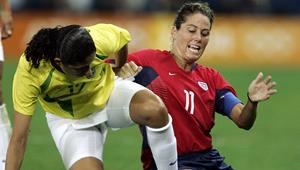
When I attend these meetings, the first thing I look for are presentations having to do with soccer, and there is enough to keep me happy meeting people from all over the world who share my interests.
One thing bothered me this year, though, and this bothers all my colleagues who deal with sports teams. Nearly half the presentations on soccer were either directly or peripherally related to nutrition or fluid replenishment. In each case, the studies were critical of the food or fluid selections that soccer players make.
The same decades-old mantra was expressed: too much protein and fat, too little carbohydrate to adequately fuel muscles for the physical demands of soccer. This was regardless of age and sex. Males and females, from professionals to youth they all chose the wrong foods.
More: Soccer 101: Positional Breakdown
My friends in other sports say the same thing. The research indicating that carbohydrate should be the bulk of caloric intake (about two-thirds of all calories) has been around for decades. The scientific community is well aware of the benefits of a high-carbohydrate diet for the competitive athlete and has been for nearly half a century.
Some sports and athletes (mostly endurance athletes like runners, cyclists, triathletes and cross-country skiers) are more conscious about nutrition and generally are pretty good about their commitment to their diet. Other sports are the worst those being aesthetic sports like figure skating, diving, gymnastics and synchronized swimming, where eating disorders are not uncommon.
An interesting interview with a quarterfinalist team in the 1994 men's World Cup revealed that half the starting-field players felt that what they ate had nothing to do with how they performed. Nothing could be further from the truth.
Carbohydrate intake and training influences how much glycogen (the main fuel for soccer) is stored in the muscles. Over 35 years ago, data was collected that showed the muscle glycogen levels of professional soccer players was little different from the spectator in the stands (not good) and that the game can completely deplete the muscles of glycogen. Thirty years ago, it was shown that the less glycogen in the muscles at the start of a game, the less the player ran in a game. Since then, research has looked at food choices and eating schedules for athletes so they can optimize their glycogen stores and delay fatigue as long as possible.
More: Drill of the Week: Soccer Stop Turn for Kids
Don't think fatigue has anything to do with the game? Were you aware that nearly 50 percent of all goals scored from round 16 on at the France World Cup were scored in the last 20 minutes of the games? So, which side do you want to be on?
Late in the game, do you want to be on the team well fueled scoring the goals or on the tired, walking team getting scored on? It is all known, published in scientific and lay books and magazines, but for some reason, the message isn't being followed.
Most nutritional surveys of youth and adolescents show rather poor nutritional choices. Most youth eat what is put in front of them at home or make poor choices when eating out. At home, players eat what their parents eat. Your parents may have chosen to be on the Atkins diet or some other very low carbohydrate program, but you shouldn't be.
More: Coaching Tips: Principles of Attacking for Youth Soccer
There is no way to play this game at a high level while eating so little carbohydrate. So if you want to put the best machine on the field of competition, you (as a kid living at home) have to advise your parents about what to prepare for you. When you go out to eat, choose high carbohydrate foods, not high protein/fat foods. This is tough if the meal is served on a tray or in a bag (i.e. fast food).
When the team travels to a tourney, pack high-carbohydrate foods instead of going to the drive-up window somewhere. I will give some eating suggestions in my next story. Be sure to review part 3 of the recovery series for suggestions regarding the timing of eating.
So where do you go to get some details? There are dozens of good training books on the shelf at your local bookstore. Two of my favorites are Power Eating by Susan Kleiner and Optimal Muscle Recoveryby Edmund R. Burke. Pick them up, read them and follow the advice. You will be a better player for it.
 Find
Find 







Discuss This Article